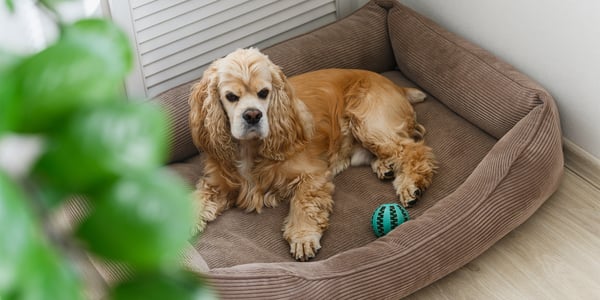The Guide to Crate Training a Cocker Spaniel
Index:



Introduction
Imagine bringing home your new Cocker Spaniel puppy, their big eyes gazing up at you with boundless curiosity and trust.
Now the work of training starts. Crate training puppies, especially Cocker Spaniels, is more than just finding a place for them to sleep. It's about creating a safe and comfortable space for them.
The process of crate training a dog, especially a lively Cocker Spaniel, can be challenging yet rewarding.
In the first few weeks, your puppy will weigh around 3-5 kilograms.
They grow fast, so picking the right size crate is crucial. This crate will be their safe space, where they can retreat from the chaos of everyday life.
With the right approach to crate training, your Cocker Spaniel will grow up feeling secure and loved. They'll be ready to thrive in your home.
Key takeaways
Crate training puppies, particularly Cocker Spaniels, involves creating a safe and comfortable space.
Select a crate that accommodates your puppy's growth to ensure longevity and comfort.
Spend at least 30 minutes with the puppy inside the crate to help them acclimatise.
Use toys and treats to encourage voluntary crate entry, creating positive associations.
Crate training aids in potty training as dogs usually avoid soiling their den.
Patience and gradual steps are key to successful crate training and developing positive habits.
Ensure the crate size allows your puppy to stand, turn, lie down, and stretch comfortably.
What is crate training?
Crate training is a great way for Cocker Spaniel owners to help their dogs. It uses dogs' natural desire for a safe spot. This method offers many benefits, like housetraining and helping with separation anxiety.
Picking the right crate and using the right training methods is key for a positive experience for your dog.
Benefits of crate training
Crate training has many advantages. It uses a dog's instinct to find a safe spot, making them feel secure.
This helps with housetraining because dogs usually don't want to soil their sleeping area. This makes it easier for owners to keep their homes clean.
It also helps with separation anxiety. A crate becomes a safe place for your dog when you're not there. This reduces bad behaviour. Training to help with anxiety becomes easier with a routine.
Selecting the right crate
It's important to pick a crate that fits your Cocker Spaniel's size now and in the future. The crate should let your dog stand, turn around, and lie down easily.
In a typical, helpful fashion Waggel provides you a range of options to choose from:
Pets at Home Single Door Crate
An affordable option with easy assembly and a foldable design.Lords & Labradors Dog Crate with Savanna Cushion and Bumper
A premium option with two doors and a foldable design.AllPetSolutions Folding Dog Crate
A large folding kennel suitable for bigger dogs.HugglePets Fabric Crate Foldable Pet Carrier
A soft, fabric option for smaller dogs or travel.
These crates offer a range of options for different needs and budgets, from basic wire crates to more luxurious models with added features. Most are foldable for easy storage and transport, making them convenient for both home use and travel.
Where you put the crate matters, too; place it in a quiet spot that's easy for the family to reach. For puppies, having the crate near your bed is good for easy bathroom breaks at night.
Start crate training by slowly introducing your dog to the crate in a positive way. Give them treats to help them get used to it.
We also recommend:
Starting with short crate times and increase them slowly.
Using toys to keep your dog calm and busy.
Having a mix of crate time and playtime to meet your dog's needs.
Using the right crate and training tips will help your Cocker Spaniel be happy and well-adjusted.



Steps to crate training a Cocker Spaniel
Crate training a Cocker Spaniel takes patience and perseverance. It's important to do it in steps to make it positive. This way, your dog will see the crate as a good place.
Introducing the crate
Start by making the crate a welcoming space for your Cocker Spaniel. Put treats and their favourite toys inside to encourage them to explore. Keep things calm and stress-free.
Let your dog enter the crate at their own pace. Use gentle encouragement and rewards to boost their curiosity. This step is key to successful crate training.
“Building a positive association with the crate from the start is essential for long-term success in crate training.”
Feeding inside the crate
Feeding your Cocker Spaniel inside the crate helps build a strong bond. Place their bowl inside the crate during meals. This links the crate to food and comfort.
Start by closing the crate door a little while your dog eats. Do this more as time goes on. This makes the crate a safe space and part of their daily life.
Follow these steps and be consistent for effective crate training. This way, your dog will see the crate as safe and comfy. Always think about your dog's comfort and well-being when using the crate.



Common challenges and tips
Dealing with whining and anxiety in crate training is quite common. It's important to be resilient and understand the issue. Using the right methods to handle whining and anxiety can make crate training a success.
Handling whining and anxiety
Many dogs, especially older ones or those rescued from tough pasts, whine and show anxiety.
Don't give in to their whining by opening the crate right away. Wait for them to calm down first. Using verbal commands and giving them chew toys can help, too.
If your dog has severe separation anxiety, getting help from a behaviour specialist is a good idea. (Waggel members get free access to our resident expert, Junior Hudson. Read our guide to pet insurance to learn if Waggel is right for you). Remember, being consistent and patient is crucial, and it's important to ensure the crate is a happy place, not a punishment spot.
Explore our detailed guide on the causes of dogs foaming at the mouth and concerns to understand more about dog anxiety and related issues. For tips on grooming and caring for your Cocker Spaniel, read our guide on how to groom a Cocker Spaniel.
Choosing the perfect crate
It's key to pick a crate that lets your dog stand up, turn around, and lie down easily.
This is especially true for older dogs, as a small crate can make them more stressed. The right size crate is vital, whether it's for a puppy or a big dog.
Fabric crates are great for moving around, while wire/metal crates are better for cars. Feeding your dog inside the crate can also make them think of it as a good place.
Here are some tips for choosing the right crate:



Conclusion
Crate training a Cocker Spaniel can greatly improve the bond between you and your pet.
It offers a quiet spot for them to rest and helps with house training. It also makes a secure place for your dog.
This training is key to being a responsible dog owner and keeps your dog happy and well-adjusted.
Encouraging your Spaniel to enter the crate during the day can ease stress and separation anxiety.
By understanding your dog's needs and using the right methods, crate training should be a positive experience. It builds a strong and trusting bond with your dog.
For insights on other popular dog breeds, visit our article on the most popular dog breeds.



Short answers to your questions
What are the benefits of crate training a dog?
Crate training has many advantages. It gives your dog a safe and comfy spot. It helps with house training and reduces separation anxiety. It also provides a dependable place for your dog in stressful situations.
How do I choose the right crate for my Cocker Spaniel?
Pick a crate that fits your puppy's current size and expected adult size. It should let them stand, turn, and lie down easily. Make sure the crate will still fit as they grow.
What is the best way to introduce my puppy to a crate?
Start by introducing the crate calmly, with treats and toys inside. Let your puppy go in on their own. Begin with short crate times and slowly increase them.
Can feeding my dog inside the crate help with the training process?
Yes, feeding your dog in the crate can make it a positive place. It teaches them the crate is for eating and feeling safe.
How should I handle whining and anxiety during crate training?
Stay patient and don't reward bad behaviour. Wait for your dog to calm down before letting them out. Keep the crate a safe, positive space, not a punishment.
What should I do if my puppy cries during the night in his crate?
Check if your puppy needs to go outside first. If not, try to calm them down without taking them out of the crate. Make the crate comfy with blankets and toys. Putting the crate in your bedroom can also help.
Can crate training help with house training my dog?
Definitely, crate training helps with house training by making your dog hold their bladder. Regular potty breaks outside can help set a routine.
Is it suitable to use a crate to manage a dog's separation anxiety?
Yes, crates can offer a secure space for dogs with separation anxiety. Make sure the crate is a positive place. Gradually increase the time your dog spends in it while you're away. Balance crate time with enough exercise and social time.
Should I leave the crate door open or closed?
Start with the crate door open to let your puppy explore. Once they're comfortable, close the door for a short time. Gradually increase the time they're in the crate with the door closed.
Waggel Pet Insurance
Need more help? You're in luck if you're a Waggel Pet Insurance member. Along with our excellent coverage, we offer access to a 24/7 online vet to answer all your sticky questions, especially if you need grooming assistance.
Not a member? Why not get a quote now and cover your furry friend for a range of illnesses, all while enjoying our amazing perks and rewards.
Want more like this?
Get updates from us with helpful info, advice, answers to frequently asked questions and much more.
Index:
Related posts:
Get your quote
Along with our excellent coverage, we offer access to a 24/7 online vet to answer all your sticky questions.





